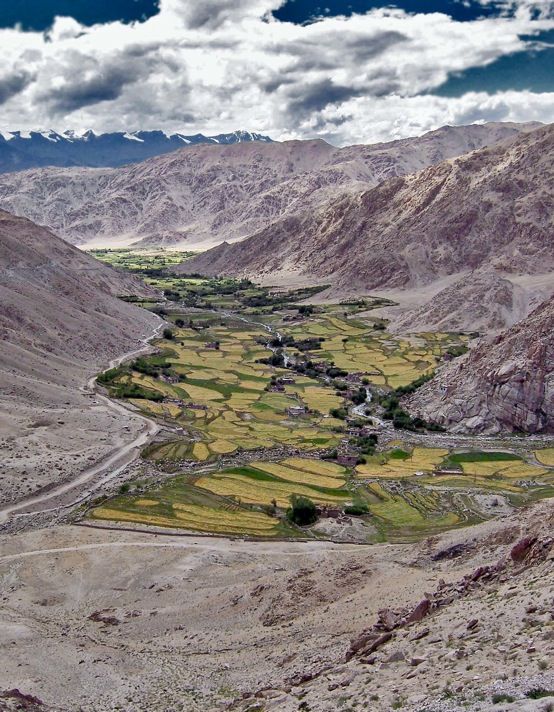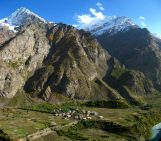Picture yourself in the Himalaya mountain belt: millions of years of continental uplift have produced a vast kingdom of towering monoliths, and they continue to grow as the Indian plate pushes further north into the heart of Asia. These dramatic, breath-taking and downright enormous geological structures can be simplified into the following tectonic units: the Leugogranites, the Transhimalaya, the Suture Zone, the Tethys Himalaya, the High Himalayan Crystalline Sequence and the Lesser Himalaya.

Himalayan geology, showing exactly where you can find the view below! [modified after O’Brien, 2011]

“Ladakh” by Franziska Wilke. The Indus River feeds the agricultural oasis in Franziska’s photo, a vivid contrast to the surrounding geology! It is distributed by the EGU under a Creative Commons licence.
This view is to the south, where the Tethyan Sedimentary Zone overlies the Higher Himalayan Crystalline (HHC). The HHC has been thrust southward onto the Lesser Himalaya through the northward progression of the Indian plate and the resulting stacked sequence forms a barrier to rainfall so that regions to the north are only marginally affected by the monsoon. One such area is the Tso Morari. The Tso Morari Crystallines contain large eclogite bodies (up to a metre across!). Eclogites are very dense bodies of rock that form under pressures far greater than those at the Earth’s crust (over 1.2 Giga Pascales). The eclogites found here contain a mineral assemblage that reflects this: garnet, rutlie, coesite and quartz to name just a few!
Franziska studied Kaghan eclogites, sampled during a former field campaign in Pakistan by her supervisor, Professor Patrick O’Brien. Since travelling in Pakistan was, and is, quite dangerous these days, she decided to attend the Himalaya-Karakoram-Tibet Workshop in northern India rather than going to Pakistan herself, because she wanted to see the Himalayan eclogites and their relation to their host rocks. Besides having fun sampling rocks, she also enjoyed the breath-taking landscape and the opportunity to take marvellous pictures.
References:
O’Brien, P. (2011) Subduction followed by collision: Alpine and Himalyan examples. Physics of the Earth and Planetary Interiors 127, 277-291.
P. Dèzes (1999). Tectonic and Metamorphic Evolution of the Central Himalayan Domain in Southeast Zanskar (Kashmir, India). PhD Thesis. Institut de Mineralogie et Petrographie, Université de Lausanne. No. 32, ISSN 1015-3578
Imaggeo is the EGU’s online open access geosciences image repository. All geoscientists (and others) can submit their images to this repository and since it is open access, these photos can be used by scientists for their presentations or publications as well as by the press and public for educational purposes and otherwise. If you submit your images to Imaggeo, you retain full rights of use, since they are licensed and distributed by the EGU under a Creative Commons licence.


